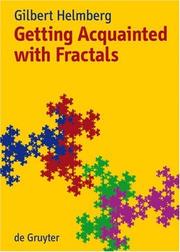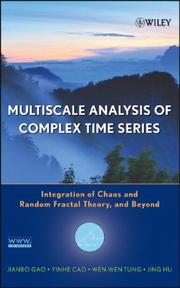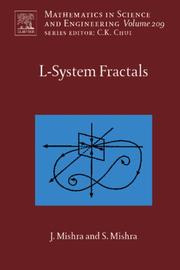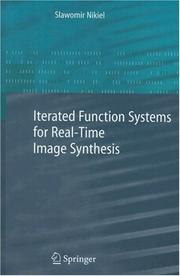| Listing 1 - 4 of 4 |
Sort by
|

ISBN: 1282196650 9786612196652 3110206617 9783110206616 9781282196650 3110190923 9783110190922 9783110190922 Year: 2007 Publisher: Berlin ; New York : Walter de Gruyter,
Abstract | Keywords | Export | Availability | Bookmark
 Loading...
Loading...Choose an application
- Reference Manager
- EndNote
- RefWorks (Direct export to RefWorks)
The first instance of pre-computer fractals was noted by the French mathematician Gaston Julia. He wondered what a complex polynomial function would look like, such as the ones named after him (in the form of z2 + c, where c is a complex constant with real and imaginary parts). The idea behind this formula is that one takes the x and y coordinates of a point z, and plug them into z in the form of x + i*y, where i is the square root of -1, square this number, and then add c, a constant. Then plug the resulting pair of real and imaginary numbers back into z, run the operation again, and keep doing that until the result is greater than some number. The number of times you have to run the equations to get out of an 'orbit' not specified here can be assigned a colour and then the pixel (x,y) gets turned that colour, unless those coordinates can't get out of their orbit, in which case they are made black. Later it was Benoit Mandelbrot who used computers to produce fractals. A basic property of fractals is that they contain a large degree of self similarity, i.e., they usually contain little copies within the original, and these copies also have infinite detail. That means the more you zoom in on a fractal, the more detail you get, and this keeps going on forever and ever. The well-written book 'Getting acquainted with fractals' by Gilbert Helmberg provides a mathematically oriented introduction to fractals, with a focus upon three types of fractals: fractals of curves, attractors for iterative function systems in the plane, and Julia sets. The presentation is on an undergraduate level, with an ample presentation of the corresponding mathematical background, e.g., linear algebra, calculus, algebra, geometry, topology, measure theory and complex analysis. The book contains over 170 color illustrations.
Fractals. --- Geometry. --- Mathematics --- Euclid's Elements --- Fractal geometry --- Fractal sets --- Geometry, Fractal --- Sets, Fractal --- Sets of fractional dimension --- Dimension theory (Topology) --- measure theory.

ISBN: 9780471654704 Year: 2007 Publisher: Hoboken, N.J. Wiley-Interscience
Abstract | Keywords | Export | Availability | Bookmark
 Loading...
Loading...Choose an application
- Reference Manager
- EndNote
- RefWorks (Direct export to RefWorks)
Time-series analysis --- Chaotic behavior in systems --- Fractals --- Série chronologique --- Chaos --- Fractales --- Chaotic behavior in systems. --- Fractals. --- Time-series analysis. --- Série chronologique --- Fractal geometry --- Fractal sets --- Geometry, Fractal --- Sets, Fractal --- Sets of fractional dimension --- Dimension theory (Topology) --- Chaos in systems --- Chaos theory --- Chaotic motion in systems --- Differentiable dynamical systems --- Dynamics --- Nonlinear theories --- System theory --- Analysis of time series --- Autocorrelation (Statistics) --- Harmonic analysis --- Mathematical statistics --- Probabilities

ISBN: 1280751878 9786610751877 0080469388 0444528326 9780444528322 9780080469386 Year: 2007 Volume: v. 209 Publisher: Amsterdam ; Boston, MA : Elsevier B. V.,
Abstract | Keywords | Export | Availability | Bookmark
 Loading...
Loading...Choose an application
- Reference Manager
- EndNote
- RefWorks (Direct export to RefWorks)
The book covers all the fundamental aspects of generating fractals through L-system. Also it provides insight to various researches in this area for generating fractals through L-system approach & estimating dimensions. Also it discusses various applications of L-system fractals. Key Features: - Fractals generated from L-System including hybrid fractals - Dimension calculation for L-system fractals - Images & codes for L-system fractals - Research directions in the area of L-system fractals - Usage of various freely downloadable tools in this area - Frac
Computer vision. --- Computer vision. L systems. Fractals. --- Fractals. --- L systems. --- Computer vision --- L systems --- Fractals --- Geometry --- Applied Physics --- Mathematics --- Engineering & Applied Sciences --- Physical Sciences & Mathematics --- Fractal geometry --- Fractal sets --- Geometry, Fractal --- Sets, Fractal --- Sets of fractional dimension --- L developmental languages --- Lindenmayer developmental languages --- Lindenmayer systems --- Machine vision --- Vision, Computer --- Dimension theory (Topology) --- Developmental biology --- Formal languages --- Machine theory --- Artificial intelligence --- Image processing --- Pattern recognition systems --- Mathematical models

ISBN: 1280901683 9786610901685 1846286867 1846286859 1849966427 Year: 2007 Publisher: London : Springer London : Imprint: Springer,
Abstract | Keywords | Export | Availability | Bookmark
 Loading...
Loading...Choose an application
- Reference Manager
- EndNote
- RefWorks (Direct export to RefWorks)
Natural phenomena can be visually described with fractal-geometry methods, where iterative procedures rather than equations are used to model objects. With the development of better modelling algorithms, the efficiency of rendering, the realism of computer-generated scenes and the interactivity of visual stimuli are reaching astonishing levels. Iterated Function Systems for Real-Time Image Synthesis gives an explanation of iterated function systems and how to use them in generation of complex objects. Contents include: •Discussion of the most popular fractal models applied in the field of image synthesis. •Presentation of iterated function system models, including recent developments in IFS representation. •Exploration of algorithms for creating and manipulating fractal objects, and techniques for implementing the algorithms. •Use of practical examples to demonstrate the implementation and application of IFS models. The book contains both a description text and pseudo-code samples for the convenience of graphics application programmers. Slawomir Nikiel is an Assistant Professor at the Institute of Control and Computation Engineering, University of Zielona Góra. He started working with fractal geometry in 1995. His current research interests include fractal image synthesis for real-time computer graphics and virtual environments. The information in the book comes from the results of his recent research.
Computer graphics. --- Image processing --- Iterative methods (Mathematics) --- Fractals. --- Digital techniques --- Mathematical models. --- Automatic drafting --- Graphic data processing --- Graphics, Computer --- Computer art --- Graphic arts --- Electronic data processing --- Engineering graphics --- Fractal geometry --- Fractal sets --- Geometry, Fractal --- Sets, Fractal --- Sets of fractional dimension --- Dimension theory (Topology) --- Iteration (Mathematics) --- Numerical analysis --- Pictorial data processing --- Picture processing --- Processing, Image --- Imaging systems --- Optical data processing --- Computer vision. --- Computer Graphics. --- Image Processing and Computer Vision. --- Machine vision --- Vision, Computer --- Artificial intelligence --- Pattern recognition systems --- Optical data processing. --- Optical computing --- Visual data processing --- Bionics --- Integrated optics --- Photonics --- Computers --- Optical equipment
| Listing 1 - 4 of 4 |
Sort by
|

 Search
Search Feedback
Feedback About
About Help
Help News
News